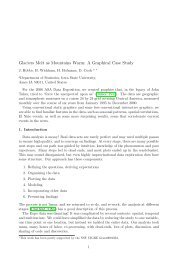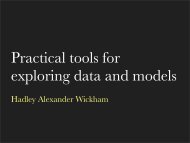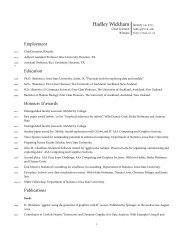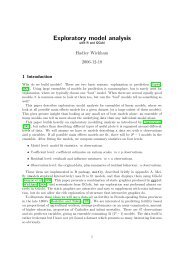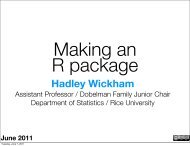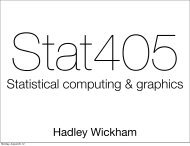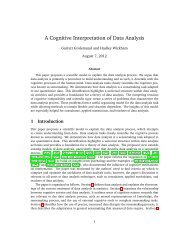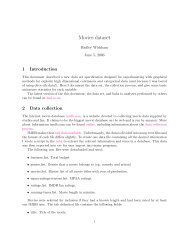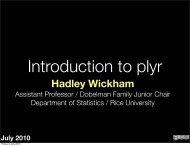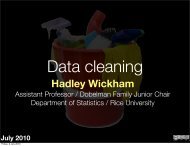Statistical inference for exploratory data analysis ... - Hadley Wickham
Statistical inference for exploratory data analysis ... - Hadley Wickham
Statistical inference for exploratory data analysis ... - Hadley Wickham
You also want an ePaper? Increase the reach of your titles
YUMPU automatically turns print PDFs into web optimized ePapers that Google loves.
<strong>Statistical</strong> <strong>inference</strong> <strong>for</strong> graphics 4371<br />
distribution, and null <strong>data</strong>sets can be simulated. The viewer’s explanation of<br />
the structure will be essential, though, because often the plot of the real <strong>data</strong> will<br />
be so obviously different from those of the simulated sets. The next two examples<br />
involve time series of stock returns, to examine whether temporal dependence<br />
exists at all; here again permutations can be used to produce reference sets.<br />
MD is examined in the fourth example, where rotation distributions are used to<br />
provide reference sets <strong>for</strong> residuals from a model fit. The fifth example examines<br />
class structure in a large p, small n problem—the question being just how much<br />
separation between clusters is due to sparsity. This might be a good candidate<br />
<strong>for</strong> the Rorschach protocol, to help researchers adjust their expectations in this<br />
area. The last example studies MD in longitudinal <strong>data</strong>, where a non-parametric<br />
model is fitted to multiple classes. Permutation of the class variable is used to<br />
provide reference sets.<br />
(i) Places Rated <strong>data</strong>: This example comes from Boyer & Savageau (1984) where<br />
cities across the USA were rated in 1984 according to many features. The <strong>data</strong> are<br />
also of interest because of two peculiarities: they consist of aggregate numbers<br />
<strong>for</strong> US metropolitan areas, and they <strong>for</strong>m a census, not a random sample. In<br />
spite of these non-statistical features, it is legitimate to ask whether the variables<br />
in this <strong>data</strong>set are associated, and it is intuitive to use random pairing of the<br />
variable values as a yardstick <strong>for</strong> the absence of association. The variables we<br />
consider are ‘Climate-Terrain’ and ‘Housing’. Low values on Climate-Terrain<br />
imply uncom<strong>for</strong>table temperatures, either hot or cold, and high values mean more<br />
moderate temperatures. High values of Housing indicate a higher cost of owning a<br />
single family residence. The obvious expectation is that more com<strong>for</strong>table climates<br />
call <strong>for</strong> higher average housing costs. The null hypothesis <strong>for</strong> this example is<br />
H0: Housing is independent of Climate-Terrain.<br />
The decoy plots are generated by permuting the values of the variable Housing,<br />
thus breaking any dependence between the two variables while retaining the<br />
marginal distributions of each. Figure 3 shows the lineup. The reader’s task is<br />
to pick out the plot of the real <strong>data</strong>.<br />
(a) Is any plot different from the others?<br />
(b) Readers should explicitly note why they picked a specific plot.<br />
(ii) Tips Data: This <strong>data</strong>set was originally analysed in Bryant & Smith (1995).<br />
Tips were collected <strong>for</strong> 244 dining parties. Figure 4 shows a histogram of the tips<br />
using a very small bin size corresponding to 10 cent widths. The null plots were<br />
generated by simulating samples from a normal distribution having the same<br />
range as the real <strong>data</strong>. Which histogram is different? Explain in detail how it<br />
differs from the others.<br />
(iii) HSBC (‘The Hongkong and Shanghai Banking Corporation’) daily stock<br />
returns: two panels, the first showing the 2005 <strong>data</strong> only, the second the more<br />
extensive 1998–2005 <strong>data</strong> (figure 5). In each panel, select which plot is the most<br />
different and explain why.<br />
(iv) Boston Housing Data: This <strong>data</strong>set contains measurements on housing<br />
prices <strong>for</strong> the Boston area in the 1970s. It was discussed in Harrison &<br />
Rubinfeld (1978), used in Belsley et al. (1980) and is available at Vlachos (2005).<br />
Phil. Trans. R. Soc. A (2009)<br />
Downloaded from<br />
rsta.royalsocietypublishing.org on January 7, 2010



